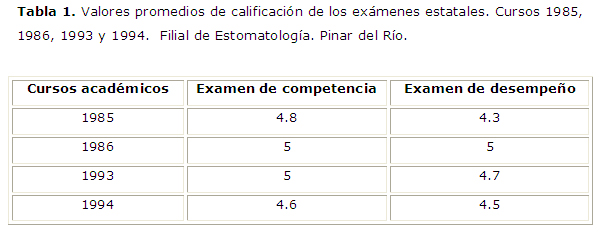The state examination, a useful reference to the methodological work of Dentistry specialty
Keywords:
Teaching, Dentistry.Abstract
Introduction: It is of public interest to guarantee the quality of the graduate, in every society university graduates are recognized as one of the major wealth of a country and the greatest social value.
Objective: to examine the ways, styles and results of the state examinations during three stages to train human resources at dentistry specialty.
Method: a retrospective study was carried out in three stages choosing 60 state-examination certificates at random where the average qualifications and the opinion of the experts about the variables influencing on the quality of the ending results.
Results: A study carried out during the 80s and the 90s, the average of qualifications which assessed work-related competence were higher to the ones obtained in the state examinations of the final decade in the present century. The results obtained in 2008 and 2010 showed more homogenous trends with an increase in the average of qualifications at performance level and a decrease in competences. The quality of those entering the university influenced, in addition to the implementation of the new methodological along with the administrative work styles in the teaching staff conforming the discipline of integration.
Conclusion: The state examination constitutes a moment in the system of the curricular evaluation, it contains a high methodological value to the work of the special didactics of the diverse teaching staffs that make up the Syllabus of dentistry studies.
Downloads
References
1. Backhoff E, Larrazolo N, Rosas N. Nivel de dificultad y poder de discriminación del examen de habilidades y conocimientos básicos. (EXHCOBA). Rev electrónica de Inv Educ[internet]. 2000[citado enero 2012];2(1):11-28. Disponible en: http://redie.uabc.mx/vol2no1/contenido-backhoff.html
2. Vicedo Tomey A. Cinco propuestas doctrinales en relación con la formación por competencias. Rev Edu Med [internet]. 2011[citado enero 2012]; 25(3): 2011. Disponible en: http://bvs.sld.cu/revistas/ems/vol25_3_11/ems14311.htm
3. González Díaz C, Sánchez Santos L. El diseño curricular por competencias en la educación médica. Edu Med Sup [internet]. 2003[citado enero 2012]: 17(4): Disponible en: http://bvs.sld.cu/revistas/ems/vol17_4_03/ems04403.htm
4. Moreno Montañez M, Quintana Regalado G. Caracterización del examen estatal escrito en la especialidad de Medicina General Integral. Edu Med Sup[internet]. 2009[citado enero 2012]; 23(3): Disponible en: http://bvs.sld.cu/revistas(ems)vol23-3-09/ems03309.htm
5. Pernas Gómez M. et al. Propuesta de sistema de trabajo metodológico para la carrera de Licenciatura en Enfermería. Edu Med Super[internet]. sept 2010 citado enero 2012]; 24(3): 320.343. Disponible en: http://www.bvs.sld.cu/revistas/ems/vol_24_3_10/ems05310.htm
6. D`Ambrosio U. Evaluación del rendimiento de del alumno. Investigación en la sala de clases: acciones pedagógicas complementarias. Boletín de Proyecto Principal de Educación en América Latina y el Caribe. agosto 1996; (40).
7. Pernas Gómez M, Zubizarrerta Estévez M, Miralles Aguilera E, Bello Fernández N, Quesada Rodríguez M. Acerca de las estructuras asesoras metodológicas para la aplicación del nuevo modelo de formación de enfermeros en Cuba. Edu. Med. Super [internet]. dic 2008[citado enero 2012]; 22(4): Disponible en: http://bvs.sld.cu/revistas/ems/vol22_4_08/ems03408.htm
8. Carrero de Celis R, Salgado González L. Otros aspectos de la evaluación histórica de la educación médica superior en Cuba desde 1959 hasta el 2004. Edu. Med Sup [ìnternet]. 2005[citado enero 2012]; 19(3): Disponible en: http://bvs.sld.cu/revistas/ems/vol19_3_05/ems08305.htm
9. Fiallo JP. Las relaciones interdisciplinares una vía para incrementar la calidad de la educación. Habana: Edit. Pueblo y Educación; 1996: 7-10.
10. Cruz Borroto ER, Salas Perea RS. Acreditación en la evolución Universitaria. Educ Med Sup [internet]; 2004[citado enero 2012]; 18(3): Disponible en: http://bvs.sld.cu/revistas/ems/vol18_3_04/ems01304.htm
11. Salas Perea RS. Propuesta de estrategia para la evaluación del desempeño laboral de los médicos en Cuba. Edu Med Super [internet]. 2010[citado enero 2012]; 24(3):387-417. Disponible en: http://scielo.sld.cu/scielo.php?script=sci_arttext&pid=S0864-21412010000300011&lng=es.
12. Lima Sarmiento L, Pérez Esquivel GJ, Díaz Molleda M, Rodríguez Milera JD, Montano Luna JA. La aplicación del sistema de evaluación en la asignatura de Morfofisiología Humana III, desde la perspectiva del profesor. Educ. Med. Super [internet].2010 [citado enero 2012]; 24(3):298-311. Disponible en: http://bvs.sld.cu/revistas/ems/vol_24_3_10/ems04310.pdf
13. Blanco Aspiazu MA, Morales González H, Rodríguez Collar TL. Actividad, acciones y operaciones en el proceso de diagnóstico. Educ Med Sup [internet]. 2010 [citado enero 2012]; 24(3): 352-359. Disponible en: http://bvs.sld.cu/revistas/ems/vol_24_3_10/ems07310.htm
14. Ramos Hernández L, Prida Reinal M, Basulto Gómez ML. Satisfacción de los estudiantes con el procedo formativo en la Escuela de Medicina de Zanzibar. Edu Med Sup [internet], Dic 2011 [citado enero 2012]; 25(4):428-435. Disponible en: http://bvs.sld.cu/revistas/ems/vol25_4_11/ems05411.htm

Published
How to Cite
Issue
Section
License
Authors who have publications with this journal agree to the following terms: Authors will retain their copyrights and grant the journal the right of first publication of their work, which will be publication of their work, which will be simultaneously subject to the Creative Commons Attribution License (CC-BY-NC 4.0) that allows third parties to share the work as long as its author and first publication in this journal are indicated.
Authors may adopt other non-exclusive license agreements for distribution of the published version of the work (e.g.: deposit it in an institutional telematic archive or publish it in a volume). Likewise, and according to the recommendations of the Medical Sciences Editorial (ECIMED), authors must declare in each article their contribution according to the CRediT taxonomy (contributor roles). This taxonomy includes 14 roles, which can be used to represent the tasks typically performed by contributors in scientific academic production. It should be consulted in monograph) whenever initial publication in this journal is indicated. Authors are allowed and encouraged to disseminate their work through the Internet (e.g., in institutional telematic archives or on their web page) before and during the submission process, which may produce interesting exchanges and increase citations of the published work. (See The effect of open access). https://casrai.org/credit/


